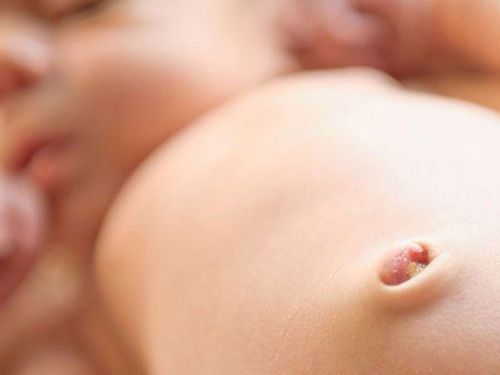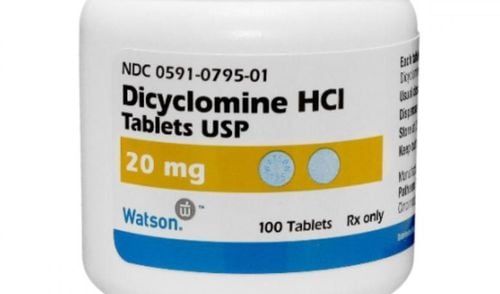This is an automatically translated article.
The article was professionally consulted by Specialist Doctor II Tran Van Trong - Specialist in Pediatric Surgery, Plastic Surgery - Aesthetics - Department of General Surgery - Vinmec Danang International Hospital.Hypertrophic pyloric stenosis is a common neonatal emergency that causes gastric outlet obstruction and is the most common surgical cause of vomiting. Why do children have hypertrophic pyloric stenosis?
1. What is hypertrophic pyloric stenosis?
Hypertrophic pyloric stenosis is a congenital disease in the gastrointestinal tract caused by the thickening of the pyloric muscle layer (the part connecting the stomach to the small intestine) causing the pyloric lumen to narrow, causing food to pass from the stomach to the stomach. The stomach cannot pass to the intestines.Hypertrophic pyloric stenosis, if diagnosed late and treated incorrectly, will lead to dehydration, rapid weight loss, severe exhaustion and difficulty in recovery. The advancement of surgical techniques and anesthesia resuscitation in recent times has brought about very positive results for pediatric patients.
Hypertrophic pyloric stenosis treatment is mainly surgical. Before surgery, the patient can be treated with rehydration and electrolyte replacement therapy.
Ultrasonography of hypertrophic pyloric stenosis shows that the pylorus myoma is a hypoechoic ring that is the location of the pyloric muscle hypertrophy and the central hyperechoic region corresponding to the narrowed pyloric canal.
2. Why do children have hypertrophic pyloric stenosis?
Up to now, the cause of hypertrophic pyloric stenosis has not been known. Some authors give some reasons such as:Hypertrophic pyloric stenosis according to many authors is a congenital pathology. Hypertrophic pyloric stenosis may be related to pyloric control hormones such as elevated gastrin causing hypertrophic pyloric stenosis. Some authors suggest that it is related to the nerve innervation of the pylorus. Due to the lack of inhibitory peptides, the pylorus did not relax, leading to smooth muscle hypertrophy and pyloric obstruction. Pyloric stenosis is associated with familial and genetic factors. Some patients with hypertrophic pyloric stenosis have one or more parents with hypertrophic pyloric stenosis. A sick mother is four times more likely to have a sick child than a sick father.

Hẹp môn vị là bệnh lý có liên quan đến yếu tố gia đình và di truyền
3. Clinical signs and symptoms of children with hypertrophic pyloric stenosis
Vomiting after meals: Vomiting profusely starting from the 4th to 8th week postpartum, vomiting more and more, vomiting appears after meals, vomiting milk, after vomiting the child usually wants to eat right away. Occasionally, bloody or yellow-green vomit may be vomited up. Untreated disease can lead to dehydration, weight loss, malnutrition, metabolic disturbances, and coma. Risk factors:Gender: boys are more affected than girls. Hypertrophic pyloric stenosis is more common in Caucasians of Northern Europe, less frequently in African-Americans and Asians. Premature infants: Hypertrophic pyloric stenosis is more common in premature infants than in term infants. Smoking during pregnancy: nearly doubles the risk of pyloric stenosis. Early use of antibiotics in neonates during the first week of life such as erythromycin for pertussis . In addition, babies born to mothers who used antibiotics during pregnancy also have an increased risk of pyloric stenosis. Formulation may also increase the risk of pyloric stenosis more than breast milk use.

Trẻ bú sữa công thức có nguy cơ bị hẹp môn vị cao hơn so với trẻ bú mẹ
4. Complications of hypertrophic pyloric stenosis
Hypertrophic pyloric stenosis can cause some complications such as:Physical retardation. Causes electrolyte loss due to repeated vomiting. Gastritis: repeated vomiting can cause stomach congestion, stomach bleeding. Jaundice is a rare occurrence because liver function can be affected leading to increased levels of bilirubin in the blood causing jaundice. Dr. Trong has more than 10 years of experience in Pediatric and Reconstructive - Aesthetic Surgery, and soon became one of the leading doctors in the field of Children's Surgery, especially Laparoscopic and Plastic Surgery. Plastic Surgery - Aesthetics.
To register for examination and treatment at Vinmec International General Hospital, you can contact Vinmec Health System nationwide, or register online HERE.
MORE:
What is pyloric stenosis? The cause to the illness? Pyloric stenosis: Common complications in chronic peptic ulcer disease Diagnosis and treatment of pyloric stenosis














